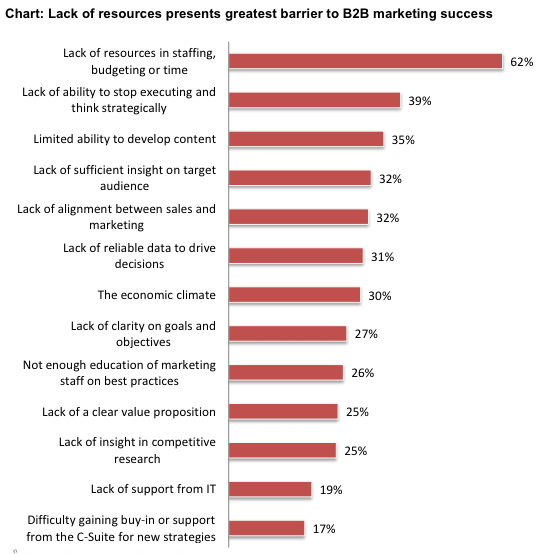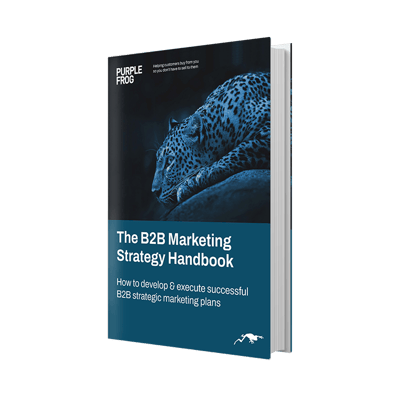Is the Way you Budget Your Marketing Spend Wrong?


Marketing should never be a blind gamble, but a calculated risk that always guarantees you a return. If this seems like an impossible dream, we show you exactly how you can make sure you double all your investments.
Managing directors, business owners and financial directors are all struggling to understand 3 things when it comes to spend management:
- How much should you be investing in marketing and sales?
- What should you spend your money on?
- How do you measure your marketing spend?
In fact, according to a B2B marketing study by MarketingSherpa, the greatest barrier to success for B2B is lack of resources in staffing, budgeting and time.

In this blog post we will concentrate on the second aspect highlighted by this research, by showing you how to budget your money and what to spend it on.
How much money should you be spending?
The first issue to solve is how much money you should be spending on marketing.
There are several different approaches you could follow, some better than others, but let's go through three of the most common ones together.
Percentage of Lifetime Value of customers
Yes, you heard us right. We are not talking about percentage of sales, which you hear mentioned a lot in other articles on the topic, but of the average lifetime value (LVT) of your customers. The ultimate goal is to always get a repeat customer, rather than sell a product or service to someone once and never see them again, and therefore you shouldn't focus on the individual sales, but on the value that customer will bring into your business over the years.
We have seen in this article how to calculate your LVT, which is given by multiplying how much money an average customer brings into your business every year and the average length of your relationship with them.
Traditionally, businesses have taken this figure and invested 10% of it in sales and marketing activities aimed at acquiring new customers, but this is all changing now, as suggested by the Gartner's marketing spending research, which found that, on average, marketing budgets are increasing by 6%.
As a general rule, we usually suggest to allocate 1/3 of the total lifetime value of your customers for a particular product to your customer acquisition strategy, so that you will always get a 3 to 1 return on your investment. However, there is what we call a risk profile that also comes into play here, which is based on your expectations of winning new customers for that particular product.
As a savvy businessman, you will always know when a product will sell less or more and what the chances are to get more customers for it, and as a result of this you will be able to calculate what percentage you want to allocate to acquiring more business for it. For some products, even a 5% investment would be enough, as they won't be able to attract a large number of customers (e.g. it's a dying technology, small market, etc.) and for some you will want to go all out and allocate a very large percentage because you believe it will certainly do well. It all boils down to being very focussed with your spend management, and truly understand your products and your customers.
There are companies that are renown for spending a huge percentage of their budget in sales and marketing because they believe so much in what they are offering that they are willing to take the risk. According to Vital, Salesforce invested a staggering 53% of their $4.1bn revenue in 2015 into their sales and marketing, which resulted in a 33% growth for the company over the previous year. Therefore, if you are 100% sure that you have a great sales proposition, your sales and marketing plan is strong as steel, and you know there is a market out there for your product or service, then you can increase the percentage you will spend on your customer acquisition.
And if you don't know your current customer acquisition cost, then you better calculate that first with the help of our free tool.
Unit of Sales
This is completely based on previous experience and it's related to the knowledge of how much marketing it takes to sell each unit. For instance, if you know you need £100 to sell a product that gives you £1,000 profit, and you need to sell 10 units over the next few months, then your marketing spend should be £10,000.
The problem with this method is that you have the risk of getting stuck in same old ways. Things that have worked in the past may not work anymore, and maybe there is a way you can be spending less and achieve better results, but you will never know it because you never really question it. What was in the past is not necessarily what is going to be in the future, and you always want to be a step ahead, not behind.
This method will only work if you keep measuring the success of your marketing (more on this in a moment) and keep revising your plan with new methods and strategies.
Objectives achievement method
Once you have concrete objectives determined, such as a 10% revenue increase for your company, you can let your marketing team estimate and determine the costs of achieving that.
This is a big risk, as there is no way to guarantee that you will get a return on the advertising your marketing team has planned, because the figure might be higher than what you can afford according to your customer acquisition cost and lifetime value calculations. Therefore it's important to compare it to these metrics to see if their quote will effectively result in a healthy return.
The other issue with this method is that it might create a whole lot of wastage. Your marketing team will tend to carry on doing what they have done in the past even if there might be something better out there that will generate more results or that can be done for a smaller investment.
What should you spend money on?
Right, now the big question, and like with any big question, there is no easy answer. Here are a few things that you should consider.
Long term or short term marketing?
CoBloom identified two different types of marketing spend:
- Long-term brand building: website design and SEO, blogging, content marketing, sales brochures, case studies, growing your social media, whitepapers, etc. These are all aimed at creating long term value and sustainable growth. If you suddenly stop doing them, their effects won't go away and you won't see a decline in traffic.
- Short-term advertising and promotion: social media campaigns, PPC, direct mail campaigns, etc. They have a short term focus and they are aimed at generating a high number of leads in a short amount of time, but their effects will inevitably stop when you stop using them.
Now, one would think that long-term is what you should be investing in, but it all depends. Yes, long term is very important, but if you are looking for a quick and effective expansion, then you should do a few short-term campaigns throughout the year that will ensure you give your business an instant kick.
Focus on revenue goals
One good piece of advice from Artillery Marketing is that, when developing a B2B marketing budget, the smart money is on revenue goals and related lead generation rather than past budgets or competitors.
The best way to do this is by bringing sales and marketing together, by making them focussed on the same revenue goals and getting them to collaborate in achieving them.
Your sales team will know the issues that customers have from talking to them every day, and if they can communicate that to the marketing team, the latter can then build campaigns around them. In this way, the marketing team will be able to generate more qualified leads that your sales team will then turn into customers.
Make sure your marketing is very focussed
As mentioned before, this all gets down to really knowing your buyer personas.
Buyer personas are semi-fictional representations of your ideal customer based on real data and some select educated speculation about customer demographics, behaviour patterns, motivations and goals. You should really take the time to create your personas, building their story and treating them as actual people, rather than abstract entities. This will help understanding their needs and challenges, connect with them and target them in a much more focussed way.
As explained in this article, you shouldn't be spending a single pound on anything that cannot guarantee you a return and that won't really resonate with as many potential customers as possible. Just because an advertising plan is guaranteed to show your product or brand to a large amount of people, you always have to ask yourself: are they the right people? Will they actually become customers after seeing it? Can I prove or measure that? If you just start splashing advertising left and right, hoping to somehow pick up some business along the way, we can guarantee that you will be throwing a lot of money to the wind.
Invest in content marketing
According to a research conducted by the content marketing Institute, the most effective marketers allocate 37%, on average, to content marketing, and more and more people are investing in it. In fact, more than half of all B2B marketers plan to increase their content marketing budget in 2016.
That is because, according to Hubspot, content marketing costs 62% less per lead than traditional marketing and generates 3 times as many leads. Getting more leads for less than half the money... wouldn't that be good?
And if you are not sure what content marketing is or how you can incorporate it into your own business, have a look at this article we have published on "What is Content Marketing?"
Don't forget about your customer experience
Gartner's marketing spending research shows that, in 2015, 18% of the overall budget in companies was invested in the customer experience to drive differentiation, innovation and profitable growth.
What you ultimately want is promoters and advocates for your products, that will effectively drive your marketing efforts forward without you having to do anything.
Think about it, we are ready to bet that quite a lot of your current "good" customers have come from recommendations from people or companies you worked with. If people like you, they will recommend you and will bring you in some extra work, so you have to make sure that you deliver a top customer experience.
Measure your Marketing Success and Revise
Don't get stuck in a rut. Your marketing strategy should never be set in stone, but continually improved on and updated as new solutions and methods come out. It should be a continuous circle of: plan, implement, measure, revise, repeat.
The way you can assess your marketing success is to always measure it together with your sales' success. The two should never be measured separately.
If you set goals that are based on revenue for your marketing team, and identify how many customers you should be acquiring each year in order to meet that target, you can measure the success of your marketing spend on whether you have met or not those goals. A simple and linear method, but one that will require your marketing team to think about things in a slightly different way and collaborate with the sales team more closely.
Conclusion
All your decisions and investments when it comes to marketing should always be based on what return in terms of revenue they can guarantee you, and because something has worked in the past, it doesn't mean it will work in the future. Technologies and buyers' mentalities are always evolving, and if there are new ways to acquire customers for a lower cost, then you should evaluate them.
How do you decide on your marketing budgets? Do you have a way to evaluate the return on your marketing spend?
More from Strategy

Customer Acquisition Cost: The Secret To Your B2B Success
Stop spending, start investing. A new approach to customer acquisition that will show you how to grow your business by...
Can Online and Offline Marketing Work Together?
I was recently asked this question by someone I was trying to explain online marketing to. It is a very interesting question if...





